The meths stove is a thing of beautiful simplicity, just air and fuel. Get the combination right and even the most basic design will be transformed into a light, efficient and usually compact travelling companion … however, get it wrong and the lightweight shine will wear off all too soon. Luckily, the inherent simplicity of meths, means that when things don’t seem to be going the way we’d hoped, the problem and thankfully, relevant solution are generally easy to find and implement … after all, there’s only two variables – fuel and air and in all probability, you’ve got too much of one and not enough of the other.
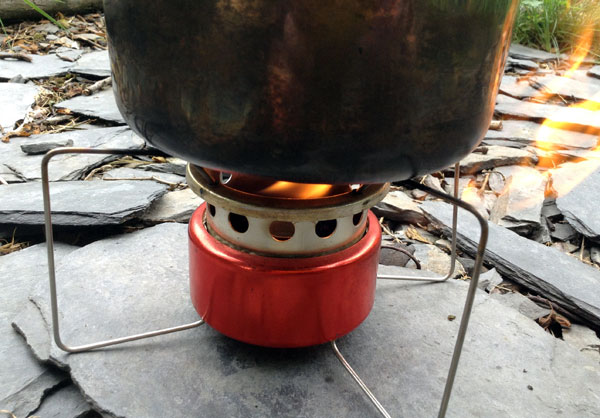 |
| Big yellow flames = too much fuel, low efficiency and sooty pans. |
I can’t get the stove to light
Unless you really are Ray Mears, the first thing to do is throw away that fire steel and get yourself a lighter or some matches.
Meths isn’t actually that volatile and the cold only makes matters worse, so if you’re still struggling to achieve ignition, try warming the fuel up by putting the bottle in your pocket, under your arm, etc for a couple of minutes just to take the edge off.
Still no joy? Sometimes it’s impossible to hold a lighter at the required jaunty angle long enough, without the burning sensation in your thumb reaching a level which forces you to let go. Try setting fire to a small piece of paper and dropping that into the stove or dip a small twig / blade of grass / someone else’s finger into the meths, light it and use that as a match.
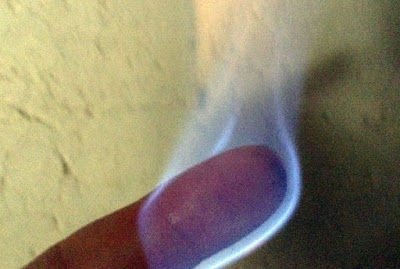 |
| Can’t light your stove? Use a makeshift match. |
My stove takes a really long time to ‘bloom’
There’s two likely culprits here, the first is cold. Warming your fuel and also your stove should help reduce bloom time but you can speed the process up considerably by pouring a SMALL amount of meths around the base of your stove and lighting it … don’t go mad and make sure your stove’s sat on something which won’t set alight.
The other likely cause is too much fuel, the more fuel in your stove, the longer it’ll take for it to vaporise and ignite … there’s probably not much you can do once it’s burning but at least you’ll know for next time.
The stove ‘shoots’ flames out
Only one reason for this … you’ve put too much fuel in your stove. It might not look like much when you put it in but remember, the fuel will ‘expand’ once it heats up and if it reaches the jets, it will ignite. Overfilling the stove won’t increase performance in any way, it’ll only reduce it and waste fuel.
My side burner stove goes out when I put the pot on
The first thing to consider is that your stove might not actually be going out. When you add a pot, the flame size will usually drop considerably and if you have a fully enclosed shield it can be quite difficult to judge what’s going on under there … lift the pot slightly and if it’s still burning you should see the flames increase in size.
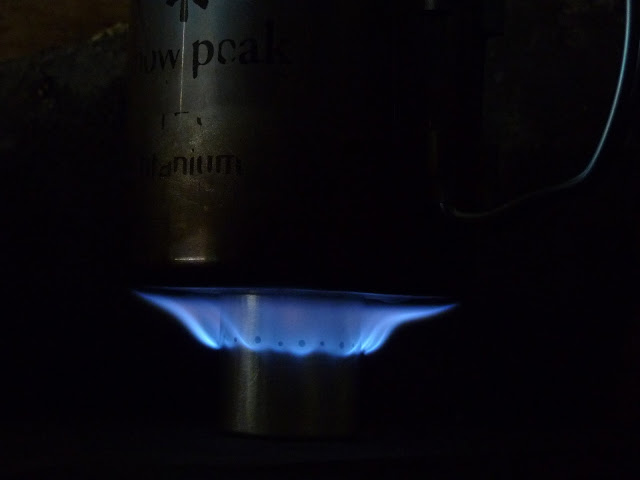 |
| You might think your stove’s gone out but this could be happening under the surface. |
If the stove definitely is going out, there’s a couple of probable causes – firstly, did you let the stove fully bloom? Did the jets fully catch or were they only starting to ‘flicker’ when you dumped the pot on top? Not sure? Give the stove another 20 seconds or so to allow it to bloom properly.
Already done that? Okay, in that case the problem is a lack of air. This might be a windshield that’s too restrictive or it might be caused by how / where the stove’s positioned. Try raising your windshield of the ground a little if possible … 3 or 4 small pebbles or twigs under the bottom edge should suffice. If you’re not able to do that, opening the shield up should improve matters although, sometimes it can cause the flames to ‘pull’ towards the air intake … achieving an even air flow around the entire shield is generally a better option.
The position of the stove can also make a massive difference … the clearer / flatter the ground around the stove the better, anything that masks the stove is a bad thing. If the ground’s uneven or grassy, don’t push the stove into the ground to stabilise it, stand it on something instead. A flat piece of stone or a bit of foil will work well – if you can’t find anything try ‘clearing’ the ground and failing that, move your stove somewhere else.
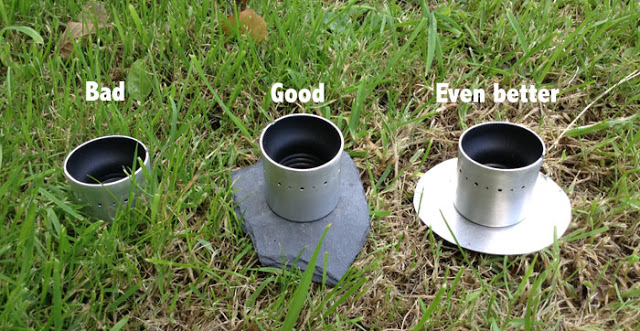 |
| Do what you can to avoid ‘masking’ the stove. The aluminium base will also reflect heat back towards the pot. |
I run out of fuel before the water’s boiled
As long as your stove’s working properly and conditions aren’t causing problems, then the cause is likely a mis-match between the chosen stove and your requirements … you’re simply trying to boil too much water with too small a stove. Sometimes, you’ll have to accept it and carry out a mid-flight re-fuelling operation.
It seems very slow to boil
Wind is the scourge of all stoves regardless of fuel type but it’ll kill the potential efficiency of a meths stove stone dead. A decent windshield (more about them here) is an integral part of any meths set-up … get it right and it’ll make a tremendous difference to how well your stove performs. The best windshields won’t only keep any heat robbing breeze away from your stove, they’ll also help focus the maximum amount of heat into / onto your pot. You can help the process along by (a) using a lid, if your pot doesn’t have one – make one, it doesn’t need to be an engineering masterpiece, a piece of foil will suffice quite nicely. Also, insulate the stove from the ground, again, a piece of foil placed under the stove will radiate a surprising amount of heat towards the important bits. While were talking heat radiation, remember that a shiny windshield will do a much better job than a posh blue/red/black/green/orange anodised one.
My pot gets really sooty
A sooty pot is an indication that your stove is ‘running rich’, there’s too much fuel burning for the available air. If it’s something that plagues you continually, then it may be down to the actual stove design. If it only happens every so often then something is changing and that ‘something’ is most likely the windshield … try and get some additional air through it without sacrificing its ability to keep the wind off.
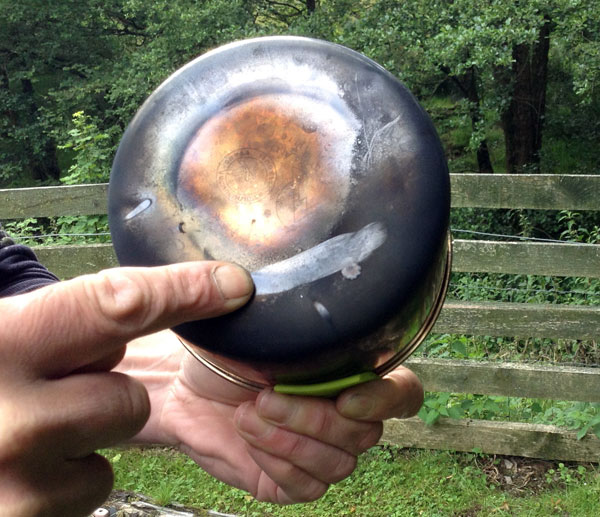 |
| If you end up with this … you need more air. |
Big yellow flames are a sure sign that there’s too much fuel being consumed. However, don’t be overly concerned about blue flames with yellow tips and also bear in mind that with some stoves, the air / fuel ratio may alter as the fuel is burnt off. In these cases you might find that the flame colour alters continuously.
Mixing a little water with your meths is sometimes suggested as a way to minimise ‘sooting’. It does work but to my mind it’s only masking the symptom of an underlying problem … adding water to your fuel will also reduce the potential heat output, which obviously means a slower boil time.
If you’ve been directly effected by anything in this post and feel you’d benefit from talking to someone, you can contact one of our trained staff 24/7 … we’re here to help ;o)

Remember if you attempt a mid-cook refuel. Check and double check that the stove and any surrounding grass are not alight.
I have a rather large scar from when I stupidly forgot to do this!!